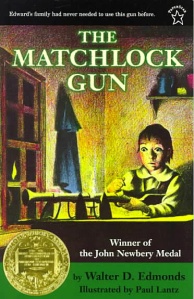 As of January 2013, I’ve achieved a goal set several years ago: to read ALL 91 winners of the Newbery Medal, awarded annually since 1922 to the best children’s book of the previous year by an American author. Along the way I’ve discovered a lot of older gems that are still just as good as when first published, some decades ago.
As of January 2013, I’ve achieved a goal set several years ago: to read ALL 91 winners of the Newbery Medal, awarded annually since 1922 to the best children’s book of the previous year by an American author. Along the way I’ve discovered a lot of older gems that are still just as good as when first published, some decades ago.
Here are several that are “coming of age” historical fiction: a boy (or young man) faces a challenge and comes through stronger, wiser, more mature. Each provides a picture of another time and place. Sometimes the language is a bit older, and the story moves at a slower pace than modern children’s novels. Some kids love them; some (particularly those assigned to read one for school) find them boring. You decide for yourself. (The year indicates when it was awarded the Newbery.)
 Johnny Tremain, by Esther Forbes (lexile: 840; AR book level: 5.9; 256 pp) 1944
Johnny Tremain, by Esther Forbes (lexile: 840; AR book level: 5.9; 256 pp) 1944
Mrs Bessie: “How old are you, Johnny?”
“Sixteen”
“And what’s that — a boy or a man?”
“A boy in time of peace, and a man in time of war.”
“Well, men have got the right to risk their lives for things they think worth it.”
The year is 1773; the scene is Boston. America is on the verge of the Revolutionary War. Johnny Tremain is a 14-year-old apprentice to a silversmith. He’s talented and proud of it — until the day a crucible of molten silver breaks and so badly burns his right hand that it’s useless. The story follows his climb from humiliation and despair to serving as a messenger and even spy for the patriots. He will rub shoulders with folk like Paul Revere and John Hancock, and ultimately be involved in the Boston Tea Party and the Battle of Lexington. The story is great for those who will enjoy the historical detail. (My 12-year-old nephew loved it, and he has excellent taste in books and uncles.)
 The Bronze Bow, by Elizabeth George Speare (lexile: 760; AR book level: 5.0; 254 pp) 1962
The Bronze Bow, by Elizabeth George Speare (lexile: 760; AR book level: 5.0; 254 pp) 1962
Witness to his father’s execution by the oppressive Romans, young Daniel bar Jamin would like nothing more than to exact his revenge and drive the Romans from their land — by violence, if necessary. His hatred leads him to join a raiding band living in the hills of Galilee. But the needs of his invalid sister force him to move back home, where he tries to continue the fight. Then he encounters a traveling teacher who is attracting great crowds, Jesus of Nazareth. Will he be the Messiah so many expect to lead the revolt against Rome? Or will he teach and model a different way, both harder and more powerful? A wonderful, historical portrayal of the turmoil of first-century Palestine, and Jesus in that context.
 Call it Courage, by Armstrong Sperry (lexile: 830; AR book level: 6.2; 95 pp) 1941
Call it Courage, by Armstrong Sperry (lexile: 830; AR book level: 6.2; 95 pp) 1941
This retelling of a traditional Polynesian legend is set in the islands of the South Pacific near Tahiti, “before the traders and missionaries first came.” Fifteen-year-old Mafatu is the son of the chief of the island of Hikueru, whose people bravely travel the seas and honor above all courage. Mafatu, however, is afraid of the sea because it took the life of his mother years before. One day he determines to face his fears and sets out in a canoe with just his dog as a companion. On the journey he will face the challenges of survival, as well as a fierce storm, wild animals, and cannibals from another island. A simply-told, engaging tale of a boy who finds courage.
 The Matchlock Gun, by Walter D. Edmonds (lexile: 860; AR book level: 5.1; 50 pp) 1942
The Matchlock Gun, by Walter D. Edmonds (lexile: 860; AR book level: 5.1; 50 pp) 1942
This short story, based on a true account handed down by one character’s family, is set in 1756 during the French and Indian War. Ten-year-old Edward Van Alstyne’s father, Teunis, is away, defending their settlement against a raid from the north. In case of attack while he is gone, Teunis has taught Edward how to fire the antique, single-shot matchlock gun kept as a family heirloom. When the Indians do come to burn their house, Edward has to summon all his courage to save his mother and little sister.
Note that some are uncomfortable with the story either because the boy is expected to kill, or because of the negative portrayal of Native Americans. Others note that it’s an accurate portrayal of the times and a historical incident.


And since I have already read the newest Newbery winner, Katherine Applegate’s truly wonderful “One and Only Ivan,” I can now say I’ve read all 92 Newbery winners.